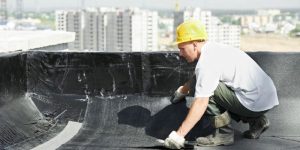For the Best in Built-up roofing, turn to the pros at DK Haney Roofing
 Built-up roofing, also known as BUR, is composed of alternating layers of reinforcing fabric and bitumen (asphalt) and finished with a top layer of aggregate like stone or gravel. Built-up roofing is popular for low slope or flat roofs because it creates a continuous sealed surface. In contrast, roof shingles are not sealed and require a relatively steep slope in order to shed water effectively. BUR is just one of the commercial roofing options we offer at DK Haney Roofing.
Built-up roofing, also known as BUR, is composed of alternating layers of reinforcing fabric and bitumen (asphalt) and finished with a top layer of aggregate like stone or gravel. Built-up roofing is popular for low slope or flat roofs because it creates a continuous sealed surface. In contrast, roof shingles are not sealed and require a relatively steep slope in order to shed water effectively. BUR is just one of the commercial roofing options we offer at DK Haney Roofing.
What are the types of Built-up roofing?
Bitumen
Bitumen can be either hot or cold. Hot means it’s heated so it liquefies during installation. Cold bitumen is more like an adhesive and is not heated.
Ply sheets
Ply sheets of built-up roofing are special fabrics reinforced with organic materials or fiberglass.
Surfacing materials
Surfacing materials, which form the top layer, may consist of small stones or fine gravel, dependent on the application.
While built-up roofing has been around for many decades, today’s built-up products provide a rigid insulation layer for enhanced energy efficiency. Most built-up roofing is comprised of three components: bitumen material, ply sheets, and one or more surfacing materials.
- Bitumen: Bitumen can be either hot or cold. Hot means it’s heated so it liquefies during installation. Cold bitumen is more like an adhesive and is not heated. Cold built-up roofing may be sprayed or applied with a squeegee and does not give off toxic fumes during application. It’s also not dependent on weather and is known for offering better performance than hot built-up roofing.
- Ply sheets: Ply sheets of built-up roofing are special fabrics reinforced with organic materials or fiberglass. Each sheet is laid over hot or cold bitumen in order to bond to the roof. Ply sheets are typically produced in a standard width of approximately 36 inches.
- Surfacing materials. Surfacing materials, which form the top layer, may consist of small stones or fine gravel, dependent on the application. This layer offers a finished look, plus it helps protect layers below from sunlight and damage from flying or falling debris. In addition, it makes the roof safe to walk on. Ballasted roofing is a special form of built-up roofing that uses large stones for the surface layer. In a ballasted system, the lower layers aren’t fastened or adhered to the roof structure; the heavy surface layer keeps the roofing in place.
What are the benefits of Built-up roofing?
One of the main benefits of Built-up roofs is that they tend to provide excellent waterproofing and ultra-violet protection. Additional benefits include:
- Fire-resistance. Due to the aggregate top layer, built-up roofs are fire-resistant.
- Low maintenance and cost-effective. Built-up roofing is generally low maintenance, thereby reducing the cost over its life.
- Built-up roofing can also have a long life-span, although it tends to do better in warmer climates than colder regions. In some cases, it can last up to 40 years.
- An additional advantage of built-up roofs is that repair is fairly easy in most cases, whether due to open joints or seams, blisters, undulations or waves, and even cracks.
Why choose DK Haney Roofing for your Built-up roofing project?
As specialists in commercial roofing services, we’re dedicated to providing customer service second to none. Over the course of our 30-plus years in business, we’re proud to have received numerous local and national accolades, including:
- Tips Outstanding Support Award
- Platinum Elite Duro-Last Contractor Since 2014
Whether you’re a contractor, architect or business owner, call DK Haney Roofing today to learn more about our built-up roofing options and why we’ve been the top commercial roofing contractor in Texas and beyond since 1991!
DK Haney Roofing
When you need a commercial roofing contractor,
we’ve got you covered!
